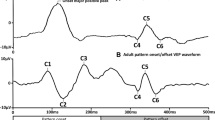Abstract
The objective of this study was to review retrospectively cases of clinically blind children in whom robust pattern visual evoked potentials (VEPs) were recorded. VEP records from a 10-year period (1990–2000) were reviewed. We searched for charts of children who were clinically cortically blind, but in whom assessment of visual acuity, using visual evoked potentials (VEPs), was normal or close to normal. The majority (77.5%) of VEP and behavioral acuity measures were concordant (subset analysis). Of the 1,113 VEP records, 9 cases (<1% of records reviewed) had clinically compromised vision with fair to good levels of visual function using VEPs. The commonality among the cases was the presence of suspected cortical visual impairment with seizures and developmental delay. VEP acuity cannot be correlated unequivocally with visually guided behaviour. In specific cases, particularly cases with developmental delay and neuroradiographic abnormalities, a child who is behaviorally blind with no clinical evidence of vision may show robust VEPs even to small patterns. This finding might be consistent with a defect of the visual association cortex.

Similar content being viewed by others
References
Frank Y, Kurtzberg D, Kreuzer JA, Vaughan HG (1992) Flash and pattern-reversal visual evoked potential abnormalities in infants and children with cerebral palsy. Dev Med Child Neurol 34:305–315
Jeffreys DA, Axford JG (1972) Source locations of pattern-specific components of human visual evoked potentials. I. Component of striate cortical origin. Exp Brain Res 16:22–40
Cohn R (1969) Visual evoked responses in the brain injured monkey. Arch Neurol 21:321–329
Spehlmann R, Gross RA, Ho SU (1977) Visual evoked potentials and post-mortem findings in a case of cortical blindness. Ann Neurol 2:531–534. doi:10.1002/ana.410020615
Bodis-Wollner I, Atkin A, Raab E, Wolkstein M (1977) Visual association cortex and vision in man: pattern-evoked potentials in a blind boy. Science 198:629–631. doi:10.1126/science.918658
Barnett AB, Manson JI, Wilner E (1970) Acute cerebral blindness in childhood. Neurology 20:1147–1156
Westall CA, Ainsworth JR, Buncic JR (2000) Which ocular and neurologic conditions cause disparate results in visual acuity scores recorded with visual evoked potential and acuity cards. JAAPOS 4:295–301
Odom JV, Bach M, Barber C, Brigell M, Marmor MF, Tormene AP, Holder GE (2004) Vaegan visual evoked potentials standard. Doc Ophthalmol 108:115–123
Sokol S, Hansen VC, Moskowitz A, Greenfield P, Towle VL (1983) Evoked potential and preferential looking estimates of visual acuity in pediatric patients. Ophthalmology 90:552–562
Frank Y, Torres F (1979) Visual evoked potentials in evaluation of cortical blindness in children. Ann Neurol 6:126–129
Hoyt CS (1984) The clinical usefulness of visual evoked response. J Pediatr Ophthalmol Strabismus 21:231–234
Clarke MP, Mitchell KW (1999) Cortically visually impaired children. Br J Ophthalmol 83:759
Clarke MP, Mitchell KW, Gibson M (1997) The prognostic value of flash visual evoked potentials in the assessment of non-ocular visual impairment in infancy. Eye 11:398–402
Lim M, Soul JS, Hansen RM, Mayer LD, Moskowitz A, Fulton AB (2005) Development of visual acuity in children with cerebral visual impairment. Arch Ophthalmol 123:1215–1220
Watson T, Orel-Bixler D, Haegerstrom-Portnoy G (2007) Longitudinal quantitative assessment of vision function in children with cortical visual impairment. Optom Vis Sci 84:471–480
Chang BC, Mirabella G, Yagev R, Banh M, Mezer E, Parkin PC, Westall CA, Buncic JR (2007) Screening and diagnosis of optic pathway gliomas in children with neurofibromatosis type 1 by using sweep visual evoked potentials. Investig Ophthalmol Vis Sci 48(6):2895–2902
Till C, Westall CA, Koren G, Nulman I, Rovet JF (2005) Vision abnormalities in young children exposed prenatally to organic solvents. Neurotoxicology 26(4):599–613
Mirabella G, Morong S, Buncic JR, Snead OC, Logan WJ, Weiss SK, Abdolell M, Westall CA (2007) Contrast sensitivity is reduced in children with infantile spasms. Investig Ophthalmol Vis Sci 48(8):3610–3615
Mirabella G, Westall CA, Asztalos E, Perlman K, Koren G, Rovet J (2005) Development of contrast sensitivity in infants with prenatal and neonatal thyroid hormone insufficiencies. Pediatr Res 57(6):902–907
Hammoudi DS, Lee SS, Madison A, Mirabella G, Buncic JR, Logan JR, Sread OC, Westall CA (2005) Reduced visual function associated with infantile spasms in children on vigabatrin therapy. Investig Ophthalmol Vis Sci 46(2):514–520
Author information
Authors and Affiliations
Corresponding author
Rights and permissions
About this article
Cite this article
Wygnanski-Jaffe, T., Panton, C.M., Buncic, J.R. et al. Paradoxical robust visual evoked potentials in young patients with cortical blindness. Doc Ophthalmol 119, 101–107 (2009). https://doi.org/10.1007/s10633-009-9176-7
Received:
Accepted:
Published:
Issue Date:
DOI: https://doi.org/10.1007/s10633-009-9176-7




